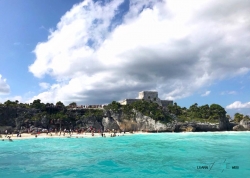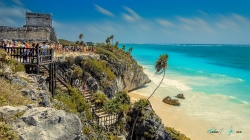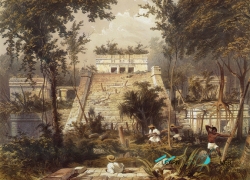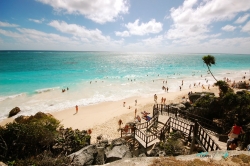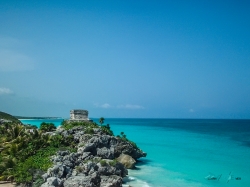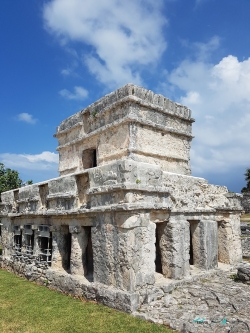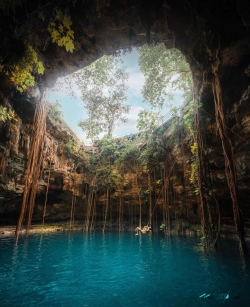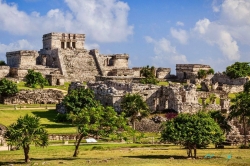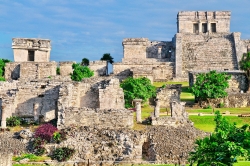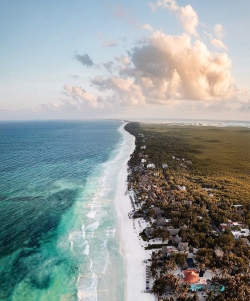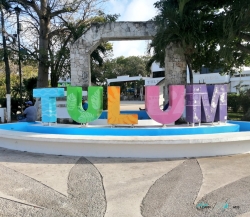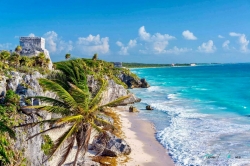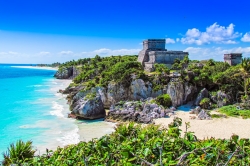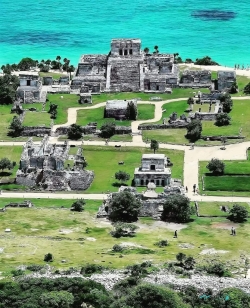Tulum is the site of a pre-Columbian Mayan walled city which served as a major port for Coba, in the Mexican state of Quintana Roo. The ruins are situated on 12-meter (39 ft) tall cliffs along the east coast of the Yucatán Peninsula on the Caribbean Sea in the state of Quintana Roo, Mexico. Tulum was one of the last cities built and inhabited by the Maya; it was at its height between the 13th and 15th centuries and managed to survive about 70 years after the Spanish began occupying Mexico. Old World diseases brought by the Spanish settlers appear to have resulted in very high fatalities, disrupting the society, and eventually causing the city to be abandoned. One of the best-preserved coastal Maya sites, Tulum is today a popular site for tourists.
The site might have been called Zama, meaning City of Dawn, because it faces the sunrise. Tulum stands on a bluff facing east toward the Caribbean Sea. Tulúm is also the Yucatán Mayan word for fence, wall or trench. The walls surrounding the site allowed the Tulum fort to be defended against invasions. Tulum had access to both land and sea trade routes, making it an important trade hub, especially for obsidian. From numerous depictions in murals and other works around the site, Tulum appears to have been an important site for the worship of the Diving or Descending god.
Tulum was first mentioned by Juan Díaz, a member of Juan de Grijalva's Spanish expedition of 1518, the first Europeans to spot Tulum. The first detailed description of the ruins was published by John Lloyd Stephens and Frederick Catherwood in 1843 in the book Incidents of Travel in Yucatan. As they arrived from the sea, Stephens and Catherwood first saw a tall building that impressed them greatly, most likely the great Castillo of the site. They made accurate maps of the site's walls, and Catherwood made sketches of the Castillo and several other buildings. Stephens and Catherwood also reported an early classic stele at the site, with an inscribed date of AD 564 (now in the British Museum's collection). This has been interpreted as meaning that the stele was likely built elsewhere and brought to Tulum to be reused.
Work conducted at Tulum continued with that of Sylvanus Morley and George P. Howe, beginning in 1913. They worked to restore and open the public beaches. The work was continued by the Carnegie Institution from 1916 to 1922, Samuel Lothrop in 1924 who also mapped the site, Miguel Ángel Fernández in the late 1930s and early 1940s, William Sanders in 1956, and then later in the 1970s by Arthur G. Miller. Through these later investigations done by Sanders and Miller, it has been determined that Tulum was occupied during the late Postclassic period around AD 1200. The site continued to be occupied until contact with the Spanish was made in the early 16th century. By the end of the 16th century, the site was abandoned completely.
In 2020, an underwater archeological expedition led by Jerónimo Avilés again excavated the cave and revealed the skeleton of a female about 30 years of age that lived at least 9,900 years ago. According to craniometric measurements, the skull is believed to conform to the mesocephalic pattern, like the other three skulls found in Tulum caves. Three different scars on the skull of the woman showed that she was hit with something hard and her skull bones were broken. Her skull also had crater-like deformations and tissue deformities that appeared to be caused by a bacterial relative of syphilis.
According to study lead researcher Wolfgang Stinnesbeck, "It really looks as if this woman had a very hard time and an extremely unhappy end of her life. Obviously, this is speculative, but given the traumas and the pathological deformations on her skull, it appears a likely scenario that she may have been expelled from her group and was killed in the cave, or was left in the cave to die there”.
The newly discovered skeleton was 140 meters away from the Chan Hol 2 site. Although archeologists assumed the divers found the remains of the missing Chan Hol 2, the analysis proved that these assumptions were erroneous in a short time. Stinnesbeck compared the new bones to old photographs of Chan Hol 2 and showed that the two skeletons represent different individuals.
Due to their distinctive features, study co-researcher Samuel Rennie suggest the existence of at least two morphologically diverse groups of people living separately in Mexico during the transition from Pleistocene to Holocene.
The site might have been called Zama, meaning City of Dawn, because it faces the sunrise. Tulum stands on a bluff facing east toward the Caribbean Sea. Tulúm is also the Yucatán Mayan word for fence, wall or trench. The walls surrounding the site allowed the Tulum fort to be defended against invasions. Tulum had access to both land and sea trade routes, making it an important trade hub, especially for obsidian. From numerous depictions in murals and other works around the site, Tulum appears to have been an important site for the worship of the Diving or Descending god.
Tulum was first mentioned by Juan Díaz, a member of Juan de Grijalva's Spanish expedition of 1518, the first Europeans to spot Tulum. The first detailed description of the ruins was published by John Lloyd Stephens and Frederick Catherwood in 1843 in the book Incidents of Travel in Yucatan. As they arrived from the sea, Stephens and Catherwood first saw a tall building that impressed them greatly, most likely the great Castillo of the site. They made accurate maps of the site's walls, and Catherwood made sketches of the Castillo and several other buildings. Stephens and Catherwood also reported an early classic stele at the site, with an inscribed date of AD 564 (now in the British Museum's collection). This has been interpreted as meaning that the stele was likely built elsewhere and brought to Tulum to be reused.
Work conducted at Tulum continued with that of Sylvanus Morley and George P. Howe, beginning in 1913. They worked to restore and open the public beaches. The work was continued by the Carnegie Institution from 1916 to 1922, Samuel Lothrop in 1924 who also mapped the site, Miguel Ángel Fernández in the late 1930s and early 1940s, William Sanders in 1956, and then later in the 1970s by Arthur G. Miller. Through these later investigations done by Sanders and Miller, it has been determined that Tulum was occupied during the late Postclassic period around AD 1200. The site continued to be occupied until contact with the Spanish was made in the early 16th century. By the end of the 16th century, the site was abandoned completely.
In 2020, an underwater archeological expedition led by Jerónimo Avilés again excavated the cave and revealed the skeleton of a female about 30 years of age that lived at least 9,900 years ago. According to craniometric measurements, the skull is believed to conform to the mesocephalic pattern, like the other three skulls found in Tulum caves. Three different scars on the skull of the woman showed that she was hit with something hard and her skull bones were broken. Her skull also had crater-like deformations and tissue deformities that appeared to be caused by a bacterial relative of syphilis.
According to study lead researcher Wolfgang Stinnesbeck, "It really looks as if this woman had a very hard time and an extremely unhappy end of her life. Obviously, this is speculative, but given the traumas and the pathological deformations on her skull, it appears a likely scenario that she may have been expelled from her group and was killed in the cave, or was left in the cave to die there”.
The newly discovered skeleton was 140 meters away from the Chan Hol 2 site. Although archeologists assumed the divers found the remains of the missing Chan Hol 2, the analysis proved that these assumptions were erroneous in a short time. Stinnesbeck compared the new bones to old photographs of Chan Hol 2 and showed that the two skeletons represent different individuals.
Due to their distinctive features, study co-researcher Samuel Rennie suggest the existence of at least two morphologically diverse groups of people living separately in Mexico during the transition from Pleistocene to Holocene.



